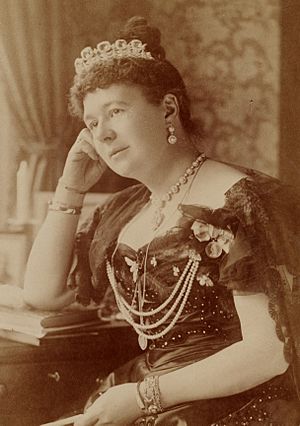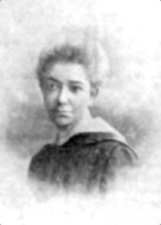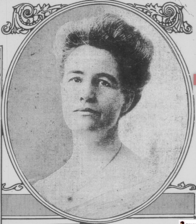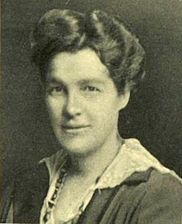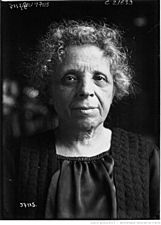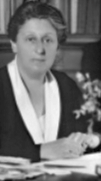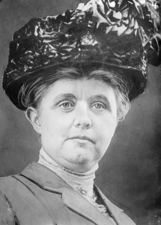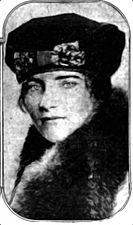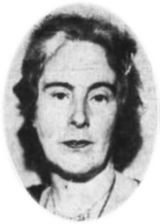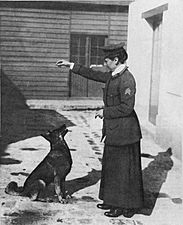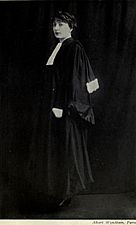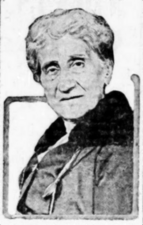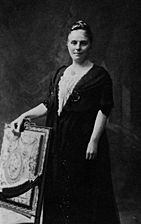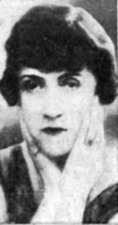Inter-Allied Women's Conference facts for kids
The Inter-Allied Women's Conference (also called the Suffragist Conference of the Allied Countries and the United States) started in Paris on 10 February 1919. It happened at the same time as the main Paris Peace Conference. The goal was to make sure that women's issues were part of the peace talks after World War I.
Leaders of the international movement for women's suffrage (the right to vote) had tried many times to join the official peace meetings. They were finally allowed to speak to the group working on international labour laws. On 10 April, the women were able to present their ideas to the League of Nations Commission. Their ideas covered women's political rights, voting rights, and changing education to include human rights for everyone in every country.
Even though the women didn't achieve all their goals, their efforts were important. It was the first time women were officially allowed to take part in talks for an international treaty. They did succeed in getting women the right to work in the League of Nations, both as staff and as representatives. They also helped get rules passed for fair working conditions and to stop human trafficking. This participation showed that women could help make international rules and brought human rights discussions to a global level.
Contents
Why the Conference Happened
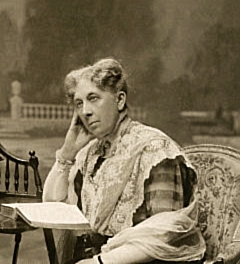
World War I changed the world a lot. Empires fell, new countries were formed, and big changes happened in politics, culture, and daily life. The Paris Peace Conference of 1919 was where leaders met to decide the terms of peace. It was a global meeting with representatives from 33 countries. They wanted to create a new international community based on fairness and law. Because of this, they asked non-governmental organisations (NGOs), which are groups not run by governments, to help. Many NGOs and lobby groups came to push for their own causes.
The Peace Conference leaders first planned to write treaties in big public meetings. But they needed to bring back stability quickly and keep some talks secret. So, the main decisions were made by the Supreme Council. This group included the prime ministers and foreign ministers from the most powerful countries: the UK, France, Italy, Japan, and the US. Many smaller groups, called commissions and committees, made up of diplomats and experts, wrote the details of the treaties. Two important commissions were the one on Labour Questions and the League of Nations Commission. These groups eventually agreed to meet with the women's representatives.
As world leaders met to plan peace, Marguerite de Witt-Schlumberger wrote to US President Woodrow Wilson. She was a leader in the International Woman Suffrage Alliance. Her letter, dated 18 January 1919, asked him to let women join the peace talks. French women who wanted the right to vote also wrote to Wilson on 25 January. They were worried about war crimes against women and that women had no official way to share their political ideas. They pointed out that women had fought alongside men and supported the war effort. So, women's issues should be discussed. Wilson said he understood their sacrifices. But he refused to give women an official role. He said their concerns were not part of the peace talks. He also said that the conference leaders could not tell governments how to run their own countries.
On 1 February, 80 French women, led by Valentine Thomson, met with President Wilson. They pushed again to be included in the peace talks. Wilson gave a similar answer. He said that job issues might be discussed, but women's civil and political rights were matters for each country to decide. At a meeting in Berne, Switzerland, in early February, women from the International Women's Committee of Permanent Peace held a special meeting. They decided to support a democratic League of Nations and women's involvement in the Paris Peace Conference.
Because of this, women from the French Union for Women's Suffrage and the National Council of French Women invited women from other countries to Paris. They planned a separate conference to start on 10 February. They invited groups working for women's voting rights in all Allied nations. They wanted delegates to come and share their views with the "official" peace conference leaders. At the same time, French feminists tried to convince the male delegates to support women's involvement. They believed that countries needed to work together to solve social and economic problems. Women from France, Italy, the UK, the US, Armenia, Belgium, New Zealand, Poland, Romania, and South Africa came to the conference.
What the Women Did
February Meetings
The main Paris Peace Conference talks happened from January to May 1919. The women's conference met from mid-February to mid-April. When the women's conference opened on 10 February, Thomson and Louise Compain helped as editors and translators. Constance Drexel, a newspaper reporter, wrote daily reports and worked with the women delegates.
On 11 February, a group led by Millicent Fawcett met with President Wilson. Fawcett was a leader in the British suffrage movement. The group included Zabel Yesayan from Armenia, who spoke about women being captured during the war. Other delegates were Margherita Ancona from Italy and Nina Boyle from South Africa. Belgian delegates included Jane Brigode and Marie Parent. British delegates were Ray Strachey and Rosamond Smith. French women included de Witt-Schlumberger, Cécile Brunschvicg, and Marguerite Pichon-Landry. US delegates were Katharine Bement Davis, Florence Jaffray Harriman, and Juliet Barrett Rublee. The women asked if a Women's Commission could be part of the peace conference to deal with issues for women and children. Wilson suggested that male diplomats form a Women's Commission instead, and the Inter-Allied Women's Conference could advise them.
The next day, a similar group met with French President Raymond Poincaré and his wife. This group included de Witt-Schlumberger, Ruth Atkinson from New Zealand, and women from Belgium, France, Italy, the UK, and possibly Australia. Three US women were also there: Harriman, Rublee, and Harriet Taylor. On 13 February, Wilson brought the women's request to the Council of Ten, a powerful group of leaders. But the women's idea was rejected again. Prime Minister Clemenceau suggested they work with the Commission on Labour.
Even after being turned down, the women kept trying to get support. They met with other peace conference delegates. These delegates agreed that women's input was important on issues like people being forced from their homes in Armenia, Belgium, Greece, France, Poland, and Serbia. They also agreed that the sale of women in Greece and the Ottoman Empire was a serious issue. By the end of February, some British women went home. They were replaced in early March by Margery Corbett Ashby and Margery Fry. Also, Graziella Sonnino Carpi from Italy and Eva Mitzhouma from Poland joined the women's conference.
March Progress
The women's conference delegates met with peace conference delegates from 16 countries. They hoped to get support for women to at least sit on committees that dealt with women's and children's issues. On 11 March, a second group of women, led by de Witt-Schlumberger, met with the Council of Ten again. This time, Wilson was not there. The peace conference delegates agreed to let the women speak to the Commission on International Labour Legislation and the League of Nations Commission. While this was less than the women wanted, it was a big step. It was the first time women were formally allowed to take part in an international treaty negotiation.
On 18 March, women who supported voting rights spoke to the Labour Commission. They talked about working conditions for women. Speakers included Ashby (UK) and several French delegates. These included Brunschvicg, Eugénie Beeckmans (a seamstress), Georgette Bouillot (a worker representative), Jeanne Bouvier (a trade unionist), Gabrielle Duchêne (a pacifist), and Maria Vérone (a lawyer). Delegates from other countries included Harriman (US), Marie d'Amalio-Tivoli (Italy), and Louise van den Plas (Belgium).
The women's conference delegates gave their ideas to the head of the Labour Commission, Samuel Gompers. Their ideas covered many issues, including health risks at work. They suggested limiting daily and weekly work hours. They also proposed a fair minimum wage based on living costs and equal pay for equal work. They asked for rules about child labour, maternity pay, and job training. They also wanted each country to create a group of women to study and advise on laws that would affect women. Two US labour leaders, Mary Anderson and Rose Schneiderman, arrived too late to speak to the Labour Commission. Instead, they met with Wilson. They urged him to let women take part in global decision-making. He promised to include women, but these promises were not kept. By the end of March, the women had convinced the delegates to add a rule. This rule said that women could work in any position in the League of Nations. Lord Robert Cecil presented this idea, and it was approved on 28 March by the League of Nations Commission.
April Presentation
Lady Aberdeen, who led the International Council of Women, arrived after the Labour Commission meeting. She helped prepare for the presentation to the League of Nations Commission. She gathered a group of women to write a statement for the delegates. Their documents focused on three main areas: women's legal status, political status, and human rights.
The women argued that international law did not properly protect women and children. They asked for international laws to provide these protections. They also suggested creating an organisation to protect public health and give advice on hygiene and disease. The statement pointed out that women suffered during wartime. But they also took on jobs that soldiers couldn't do and supported their countries. They asked for women to get the right to vote. This would allow them to help govern. The women's final point was that basic education around the world should teach about civilization and citizenship duties. This education should focus on respecting the humanity, cultures, and human rights of all people in every country.
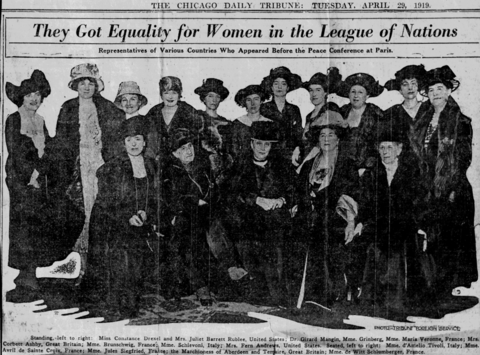
On 10 April, seventeen women from the Inter-Allied Women's Conference spoke to the League of Nations Commission. Among them were Lady Aberdeen, de Witt-Schlumberger, Ashby, Brunschvicg, Fry, Grinberg, Rublee, d'Amalio-Tivoli, and Vérone. Other French women included Gabrielle Alphen-Salvador, Nicole Girard-Mangin (a military doctor), Marie-Louise Puech, Avril de Sainte-Croix (a journalist), and Julie Siegfried. The rest of the group included Elisa Brătianu from Romania, Fannie Fern Andrews (a teacher and pacifist from the US), and Alice Schiavoni from Italy.
The delegates insisted that women should have equal access to all jobs and groups within the League. They also said that governments that did not give women equality should not be allowed to join. They argued that if people could choose their own path, women should have equal chances and the legal right to make their own life choices. Their demands for voting rights and recognition of women's civil, political, and human rights were not successful. However, Article 7 of the Covenant of the League of Nations, which was part of the Versailles Treaty, did allow women to hold any position in the League.
What Happened Next
The official peace conference delegates did not see women's citizenship and political rights as an international issue or a human rights issue. Instead, they believed each country should decide its own rules for citizenship, especially for married women. The Inter-Allied Women's Conference ideas on education, labour, and nationality were thought to be "too extreme" and were mostly ignored. The League of Nations agreement did include rules that member countries should promote fair working conditions for men, women, and children, and prevent human trafficking.
Many feminists who first supported the League of Nations were disappointed with the final terms of the Treaty of Versailles. At the Zürich Peace Conference in May 1919, the delegates strongly criticised the Treaty. They disliked its harsh punishments and that it didn't condemn violence. They also were upset that women were left out of political life. The Women for Permanent Peace (later called the Women's International League for Peace and Freedom) included many of the Inter-Allied Women's Conference ideas in their "Woman's Charter." When the International Labour Organisation was created as part of the League of Nations, it adopted the women's idea of equal pay for equal work. Its rules also said that a woman delegate should be appointed to attend the International Labour Conference when women's issues were discussed.
Women labour leaders were also unhappy with the results. They wanted to take part in the International Labour Conference in Washington, D.C., in November. Margaret Dreier Robins, a leader of the Women's Trade Union League, thought women would be blocked again. To prevent this, she led the International Congress of Working Women. This meeting started on 29 October to prepare a list of important points. During their ten-day conference, the women adopted many of the labour standards and worker rights ideas that the women's conference delegates had proposed. Many delegates from the Congress of Working Women then attended the International Labour Conference. Their strong speeches led to the passing of international labour rules for maternity leave, working hours, and child labour. These rules were a good start, even if they were not as strong as the women had hoped.
Lasting Impact
During World War II, French feminist records, along with others from Belgium, Liechtenstein, and the Netherlands, were stolen. Soviet forces later took these records to Moscow. They were kept in a secret archive. In the early 1990s, these documents were found. New policies led to them being returned to their home countries. The French records came back in 2000. The families of the feminists whose work was stolen decided that a public archive would be helpful. So, the Feminist Archives Association was created to build the Archives du Féminisme at the University of Angers. After two years of organising, the archive opened. This allowed researchers to finally study these important documents.
Because the women's initial meetings with the Peace Conference delegates were not part of the official records, and the French archives were lost for a long time, serious study of the Inter-Allied Women's Conference didn't happen until the 21st century. These new studies show that women were active in the peace process. They wanted to play public roles in shaping international policies after World War I. Historian Glenda Sluga says the women believed that women's ability to make their own choices was connected to countries becoming more democratic. In 2019, historians Mona L. Siegel and Dorothy Sue Cobble discussed the importance of the Inter-Allied Women's Conference. Siegel concluded that even though the women didn't achieve all their goals, they made women's involvement in international policy-making acceptable. They also made human rights a global topic. These successes continue to be important today.
Conference Participants Gallery



